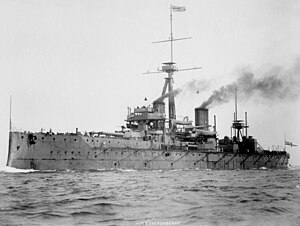HMS Dreadnought (1906)

Dreadnought at sea in 1906
|
|
| Class overview | |
|---|---|
| Name: | Dreadnought |
| Operators: |
|
| Preceded by: | Lord Nelson class |
| Succeeded by: | Bellerophon class |
| Cost: | £1,783,883 |
| Built: | 1905–1906 |
| In service: | 1906–1919 |
| In commission: | 1906–1919 |
| Completed: | 1 |
| Scrapped: | 1 |
| History | |
|
|
|
| Name: | Dreadnought |
| Ordered: | 1905 |
| Builder: | HM Dockyard, Portsmouth |
| Laid down: | 2 October 1905 |
| Launched: | 10 February 1906 |
| Commissioned: | 2 December 1906 |
| Decommissioned: | February 1919 |
| Fate: | Scrapped, 1923 |
| General characteristics (as completed) | |
| Displacement: |
|
| Length: | 527 ft (160.6 m) |
| Beam: | 82 ft 1 in (25.0 m) |
| Draught: | 29 ft 7.5 in (9.0 m) (deep load) |
| Installed power: |
|
| Propulsion: | 4 shafts; 2 steam turbine sets |
| Speed: | 21 knots (39 km/h; 24 mph) |
| Range: | 6,620 nmi (12,260 km; 7,620 mi) at 10 knots (19 km/h; 12 mph) |
| Complement: | 700–810 |
| Armament: |
|
| Armour: | |
HMS Dreadnought was a battleship built for the Royal Navy that revolutionised naval power. Her entry into service in 1906 represented such an advance in naval technology that her name came to be associated with an entire generation of battleships, the "dreadnoughts", as well as the class of ships named after her. The generation of ships she made obsolete became known as "pre-dreadnoughts". Admiral Sir John "Jacky" Fisher, First Sea Lord of the Board of Admiralty, is credited as the father of Dreadnought. Shortly after he assumed office, he ordered design studies for a battleship armed solely with 12-inch (305 mm) guns and a speed of 21 knots (39 km/h; 24 mph). He convened a "Committee on Designs" to evaluate the alternative designs and to assist in the detailed design work. One ancillary benefit of the Committee was that it would shield him and the Admiralty from political charges that they had not consulted leading experts before designing such a radically different battleship.
Dreadnought was the first battleship of her era to have a uniform main battery, rather than having a few large guns complemented by a heavy secondary armament of smaller guns. She was also the first capital ship to be powered by steam turbines, making her the fastest battleship in the world at the time of her completion. Her launch helped spark a naval arms race as navies around the world, particularly the German Imperial Navy, rushed to match her in the build-up to World War I.
In March 1915 Dreadnought became the only battleship confirmed to have sunk a submarine, when she rammed the German U-boat SM U-29.Dreadnought did not participate in the Battle of Jutland in 1916 as she was being refitted. This was the only time during the war that British dreadnought battleships fired on their German counterparts. Nor did Dreadnought participate in any of the other World War I naval battles. After the Battle of Jutland she was relegated to coastal defence duties in the English Channel, not rejoining the Grand Fleet until 1918. She was reduced to reserve in 1919 and sold for scrap two years later.
...
Wikipedia
